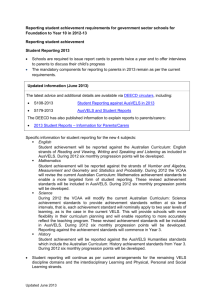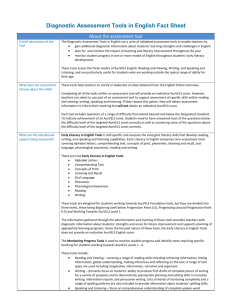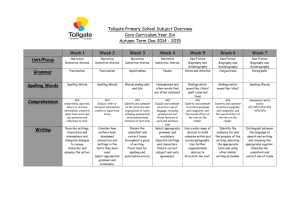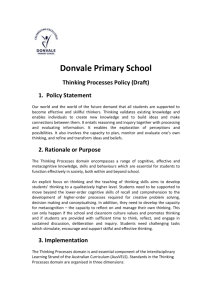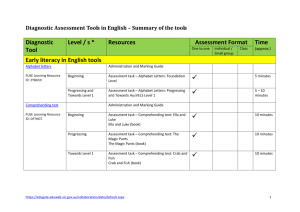Diagnostic Assessment Tools in English
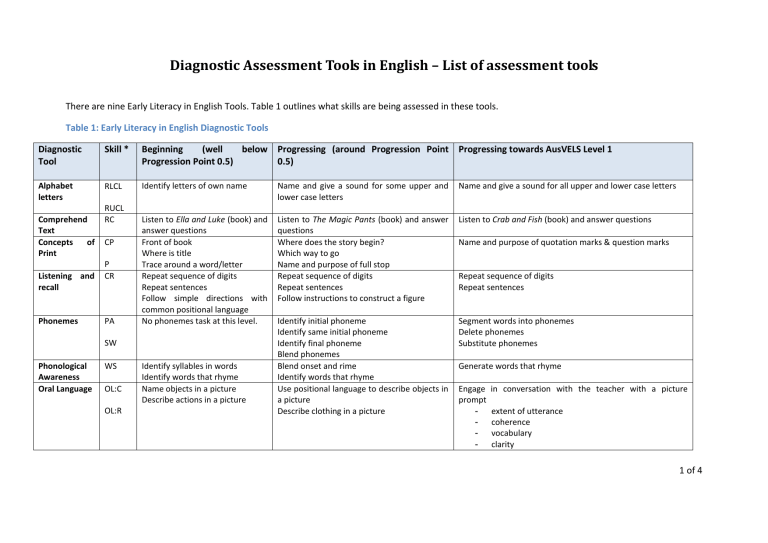
Diagnostic Assessment Tools in English – List of assessment tools
There are nine Early Literacy in English Tools. Table 1 outlines what skills are being assessed in these tools.
Table 1: Early Literacy in English Diagnostic Tools
Diagnostic
Tool
Alphabet letters
Comprehend
Text
Concepts of
Listening and recall
Phonemes
Skill * Beginning (well below
Progression Point 0.5)
RLCL Identify letters of own name
Progressing (around Progression Point
0.5)
Name and give a sound for some upper and lower case letters
RUCL
RC
CP
P
CR
PA
SW
Phonological
Awareness
WS
Oral Language OL:C
OL:R
Listen to Ella and Luke (book) and answer questions
Front of book
Listen to The Magic Pants (book) and answer questions
Where does the story begin?
Where is title
Trace around a word/letter
Repeat sequence of digits
Repeat sentences
Which way to go
Name and purpose of full stop
Repeat sequence of digits
Repeat sentences
Follow instructions to construct a figure Follow simple directions with common positional language
No phonemes task at this level. Identify initial phoneme
Identify same initial phoneme
Identify syllables in words
Identify words that rhyme
Name objects in a picture
Describe actions in a picture
Identify final phoneme
Blend phonemes
Blend onset and rime
Identify words that rhyme
Use positional language to describe objects in a picture
Describe clothing in a picture
Progressing towards AusVELS Level 1
Name and give a sound for all upper and lower case letters
Listen to Crab and Fish (book) and answer questions
Name and purpose of quotation marks & question marks
Repeat sequence of digits
Repeat sentences
Segment words into phonemes
Delete phonemes
Substitute phonemes
Generate words that rhyme
Engage in conversation with the teacher with a picture prompt
- extent of utterance
- coherence
- vocabulary
- clarity
1 of 4
Table 1: Early Literacy in English Diagnostic Tools (continued)
Diagnostic
Tool
Reading
Early Writing
Skill * Beginning (well below
Progression Point 0.5)
RA
RF
RC
W
S
WB
Read environmental print
Distinguish writing from pictures and numbers
Write own name
Write other known words
Orally dictate a sentence
Progressing (around Progression Point
0.5)
Listen to text and match words back to the text
Identify common sight words in text
Write high frequency words
Write and read back own sentence
Progressing towards AusVELS Level 1
Read a story well supported by illustrations with a simple repetitive structure
- fluency
- accuracy
Answer questions about the story
Spell some common words
Write a dictated sentence
Write and read back own sentence
Build words with common spelling pattern
* The second column of Table 1 shows the skills that are assessed in the Early Literacy in English Tools.
The abbreviations are listed below in the order in which they appear in the table:
RLCL: recognition of lower case alphabet letters
RUCL: recognition of upper case alphabet letters
CR: comprehension of retell
PA: phonemic awareness
SW: segmenting words
WS: words and sounds
RA: reading accuracy
RF: reading fluency
W: writing
S: spelling
RC: reading comprehension
CP: concepts of print
P: punctuation
OL:C: oral language conversation
OL:R: oral language retell
WB: word building
2 of 4
There are three Monitoring Progress Tools: Reading, Writing, and Speaking and Listening. Each tool has three levels: AusVELS Level 2, AusVELS Level 3 and AusVELS Level 4. The AusVELS Levels overlap in the
Speaking and Listening Tools. Table 2 outlines the tools.
Table 2: Monitoring Progress Diagnostic Assessment Tools
Diagnostic
Tool
Reading and Viewing
Tools* – covering reading comprehension, accuracy and fluency skills.
AusVELS Level 4
Reading texts provided:
Imaginative – narrative:
Aunty Jade on the Farm
Argument: Indoor
Basketball Court
Imaginative – narrative:
Finding Kit
Information – diagram:
My X-Ray Image
Information:
Edison
Thomas
AusVELS Level 3
Reading texts provided:
Information: Helicopters
Argument: Year 4 Opinion
Board
Information: Hermit Crabs
Imaginative – narrative:
The Invisible Dog
Imaginative - poem:
Danni’s Schoolbag
AusVELS Level 2
Reading texts provided:
Imaginative - narrative – A
Storm is Coming
Imaginative - narrative –
Lucky Duck Day
Information – Catbird
Instruction – Pebble Pet
Information – Westpark
Zoo
Writing Tools** – covering writing and spelling skills.
Speaking and Listening*** – covering oral language retell, comprehension retell and oral language conversation.
Report writing - Penguins
Persuasive writing - Shoes or
Garden
Narrative writing – Trees or
Shoes
Spelling list x 2
Listening Presentation: Stick
Insects
Listening Presentation: Museum
Pair Discussion: Cooked Lunches
Report writing - Penguins
Persuasive writing - Shoes or
Garden
Narrative writing – Trees or
Shoes
Spelling list x 2
Instructional Presentation:
Museum
Listening Presentation: Fruit Bats
Pair Discussion: Cooked Lunches
Pair Discussion: Classroom Pet
Listening Presentation: Stick
Insects
Report - Shoes
Persuasive - Shoes or Garden
Narrative – Trees or Shoes
Spelling lists x 2
Listening Presentation: Fruit Bats
Pair Discussion: Classroom Pet
* Reading and Viewing Tools Overview
The reading skills assessed by each text vary because different texts demand different interpretations: some texts invite ‘reading between the lines’ (inferences), in others the focus may be on the content, the form or the linking of details. It is important not to trivialise the meaning by trying to impose questions that don’t match the content of the text.
An effective assessment of reading comprehension focuses on the core meaning of the text and the interpretation of details or layers of meaning that expand and complement the core meaning. The questions cover as wide a range of relevant reading skills as possible. Each question addresses a
3 of 4
separate aspect of the text. The set of questions is designed to help teachers to find out if students have a deep and thorough understanding of the text.
All the texts have questions of a range of difficulty, regardless of the complexity of the text. There are usually only one or two literal questions about retrieving directly stated information per text as these would generally be too easy for the designated AusVELS Level.
** Writing tool overview
The writing tasks are assessed against content; organisation; sentence and paragraph structure; vocabulary; punctuation; and spelling.
Educators need to know how well students are able to write for different purposes. Knowing students’ strengths guides teachers in selecting appropriately challenging writing tasks for students to work on independently. Identifying obvious patterns of weakness in the ideas students have about what to write, the way they organise their writing, the way they construct sentences and paragraphs, the vocabulary they use and their use of punctuation and spelling, also alerts teachers to areas where students need support to develop their skills. Detailed diagnostic information about the spelling words is included in the task booklet.
*** Speaking and Listening Overview
The speaking and listening tasks are administered as digital texts. This ensures that all students have the same opportunities to recall and respond to the texts and that their responses are comparable, because they have all responded to the same task.
The pair discussions have been recorded to be as authentic a representation as possible of the kind of spoken text that students encounter in small group discussions. Pausing, unfinished sentences and ideas that are undeveloped and reworked as they are spoken are typical of this kind of spoken text. The presentations provide examples of authentic spoken texts of the kind that students would be expected to listen to and understand.
The most important diagnostic questions in speaking and listening are always about meaning. Did the student understand what they heard? Did they communicate their ideas clearly and are they able to engage in a meaningful exchange of ideas? If not, the next set of questions should be about what the student did communicate and understand and how they contributed to the exchange of ideas, as well as what they misunderstood or had difficulty communicating or how they became confused in the exchange of ideas.
4 of 4
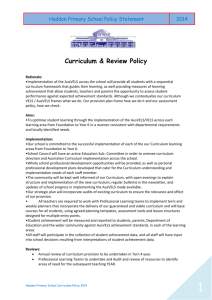
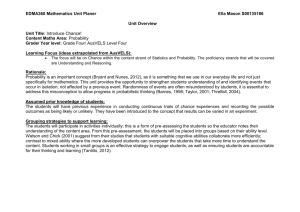
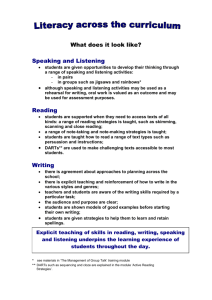

![to Learning Styles Questionnaire [MS Word,93Kb]](http://s3.studylib.net/store/data/007287401_2-741c6340dee171d22423967f2d0c2716-300x300.png)
